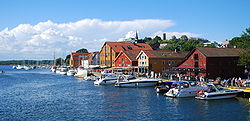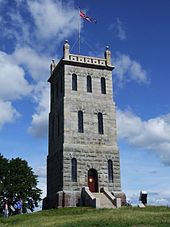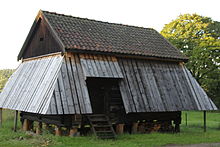Tonsberg
| coat of arms | map | |
|---|---|---|

|
|
|
| Basic data | ||
| Commune number : | 3803 | |
| Province (county) : | Vestfold and Telemark | |
| Administrative headquarters: | Tonsberg | |
| Coordinates : | 59 ° 18 ′ N , 10 ° 25 ′ E | |
| Surface: | 329.26 km² | |
| Residents: | 56,293 (Feb 27, 2020) | |
| Population density : | 171 inhabitants per km² | |
| Language form : | neutral | |
| Postal code : | 3101-3127 | |
| Website: | ||
| traffic | ||
| Railway connection: | Vestfoldbanen | |
| politics | ||
| Mayor : | Anne Rygh Pedersen ( Ap ) (2019) | |
| Located in the province of Vestfold og Telemark | ||

|
||
 Tonsberg harbor quay |
||
is a town andmunicipalityin theVestfold regionin theNorwegianprovince (Fylke)Vestfold og Telemark. The municipality borders onHolmestrandin the north,Larvikin the west,Sandefjordin the south-west,Færderin the southandHortenand theOslofjordin the east. Tønsberg city center is just north ofNøtterøy, on the peninsula betweenTønsbergfjordin the west and the fjordbasin Trælain the east. The highest point in the municipality isUndrumsåsenwith145 moh. The city coat of arms is the only original medieval city seal from 1349 that has been preserved.
geology
The place is located in a very strongly volcanic and igneous region, which is known in the geosciences as the Oslo Trench . A rare red syenite , also known as Tönsbergite , is found in the vicinity of the city . The town of Tønsberg is the type locality for this rock name, which the Norwegian geologist Waldemar Christofer Brøgger coined in 1898 and which was the first to scientifically describe the rock.
history
According to the tradition of Snorri Sturluson , Tønsberg was founded before the battle in Hafrsfjord in 871, making Tønsberg the oldest Norwegian town. The old Norwegian name of the city was Tunsberg . Doing means "fenced in space". The city celebrated its 1000th anniversary in 1871 and many consider Snorri Sturluson's statements to be correct, especially since there are hardly any other written sources from this period. However, excavations since the 1970s in the oldest parts of the city have found no evidence of such an early establishment. From 1904–1905 the Oseberg ship , the most important evidence of the city from the Viking Age, was discovered as a burial object during excavations . The construction of the ship is estimated around the year 820. The ship is now in the Vikingskipshuset Museum in Oslo . A replica of the Oseberg ship was completed in 2011 in the port of Tønsberg.
The Tunsberghus fortress on the Schlossberg was one of the royal residences and fortresses in the 12th and 13th centuries. During this time it was expanded on a large scale by the kings Håkon Håkonsson and Magnus Lagabøte . Håkon's daughter, Kristina von Tønsberg, died shortly after her marriage to the Spanish Prince of Castile. Around 1200, the representatives of the bishop's party, the Baglers , holed up in the fortress against the attacks of the Birkebeiner under King Sverre . The city was one of the country's political centers of power throughout the Middle Ages. Until 1503 the fortress was the residence of the feudal men from Tønsberg. The fortress was captured and burned down by Swedish soldiers in 1503. With eight Premonstratensian and Franciscan churches and monasteries within the city limits, it was also a spiritual center. The Tønsberg Concordat , a settlement concluded in 1277 between King Magnus Lagabøte and Archbishop Jon Raude , curtailed the previously existing privileges of the Church in jurisdiction and the Church was subordinated to the Crown. The Concordat was renewed by Christian I in 1458 .
Tønsberg was also an important trading center in Norway in the Middle Ages and was a member of the Hanseatic League from 1250 to 1530 . At the end of the 12th century, the first foreign merchants came to the city to do business. After initially only working here in summer, they became resident all year round from 1250 onwards. With the decline of the Hanseatic League, foreign merchants lost their trading privileges and Tønsberg's importance as a merchant town declined.
A great fire that destroyed most of the city in 1536 meant that parts of the city were not rebuilt for a long time and the importance of the city continued to decline in the following century.
Tønsberg only regained importance in the 17th century, especially for Norway's seafaring and whaling. By Svend Foyn , a ship owner in Tønsberg, 1864, the first whaling ships were equipped with the developed by him harpoons with garnet head. In 1739, the state salt mine "Christiansverk" was founded on the Valløy peninsula in the district of Sem, which was in operation until 1860. The oil refinery founded by ExxonMobil in 1905 was badly damaged by bombing during World War II and ceased production in the early 1950s.
During the German occupation , the National Socialist-controlled state police of the collaboration government maintained an internment and prisoner-of-war camp, the Berg camp , on the grounds of the Søndre Berg homestead approx. 4 km north of the city center , in which Jews and resistance fighters, among others, were terrorized and mistreated.
The site of the former shipyard is now the headquarters of the "Grenland Group", a company that develops and produces equipment for oil platforms and other offshore drilling systems as well as floating docks. Nowadays, Tønsberg is the capital of the province of Vestfold and an important center of trade and administration and is one of the preferred holiday resorts in Norway in the summer months.
Since 1948 Tønsberg has been the seat of the new Tunsberg diocese of the Church of Norway .
The municipality of Re was incorporated on January 1, 2020 .
Twin cities
Within the Nordic countries there are partnerships with:
In addition to this association, Tønsberg has had another town twinning with Covarrubias in the Spanish province of Burgos since 2003 .
Tønsberg, Joensuu, Linköping and Roskilde also cooperate within the MECINE (Medium Cities In Europe) network with other locations:
Culture and sights
Tønsberg is the cultural center of the Vestfold region. The Schlossberg Music Festival (July), the Tønsberg Medieval Festival (May) and the Vestfold Festival (June – July) take place here every year. The central venue for theater performances, concerts and exhibitions is the Oseberg Kulturhus.
Notable sights are:
- Ruin park on the Schloßberg with the remains of the Tunberghus fortress and the Schloßberg tower from 1888 to commemorate the 1000th anniversary of the city. The insignia of the Norwegian kings Haakon VII , Olav V and Harald V are in the tower .
- The Schlossberg Museum with exhibitions on the history of the city and the region, a small open-air museum and a huge whale skeleton
- Haugur Vestfold Art Museum, in a building from 1922, the facade of which is decorated with statues of architects from different nations
- Tønsberg Historical Maritime Museum
- Tønsberg Cathedral
Sports
In 1937, the Norwegian Ski Jumping Championship took place on Bjellandbakken in Tønsberg . In 2011 the football club FK Tønsberg played in the 2nd Norwegian league. The area around Tønsberg with around 700 archipelago islands is a paradise for water sports enthusiasts.
traffic
Tønsberg has a train station on the Vestfold Railway Skien - Drammen (- Oslo ). After Sandefjord and Strömstad (Sweden) are ferry connections.
sons and daughters of the town
Well-known people born in Tønsberg include the former Norwegian Prime Minister Johan Sverdrup , the singer Jahn Teigen and the writer Ingvar Ambjørnsen .
literature
- Ralph Tuchtenhagen : Small history of Norway. Verlag CH Beck, Munich 2009, ISBN 978-3-406-58453-4 .
- Fritz Petrick, Norway-From the beginnings to the present-, Verlag Friedrich Pustet, Regensburg 2002, ISBN 3-7917-1784-7
- Byguide Tønsberg 2011, published by Tønsberg Turistkontor
Web links
- Tønsberg in the store norske leksikon (Norwegian)
Individual evidence
- ↑ Statistisk sentralbyrå - Befolkning
- ↑ Roger Walter LeMaitre et al. IUGS : Igneous rocks. A classification an Glossary of Terms . Cambridge 2002 ISBN 0-521-66215-X p. 149
- ↑ Navn på nye kommuner. February 19, 2019, accessed October 1, 2019 (Norwegian).
- ↑ Tønsberg kommune: Nordiske vennskapsbyer. ( Page no longer available , search in web archives ) Info: The link was automatically marked as defective. Please check the link according to the instructions and then remove this notice. November 22, 2012, accessed November 24, 2012 (Norwegian)
- ↑ Tønsberg kommune: Vennskapsbyen Covarrubias - Spania. ( Memento of the original from August 10, 2013 in the Internet Archive ) Info: The archive link was inserted automatically and has not yet been checked. Please check the original and archive link according to the instructions and then remove this notice. March 4, 2011 Retrieved November 24, 2012 (Norwegian)
- ↑ Tønsberg kommune: Mecine. ( Page no longer available , search in web archives ) Info: The link was automatically marked as defective. Please check the link according to the instructions and then remove this notice. November 22, 2012, accessed November 24, 2012 (Norwegian)


